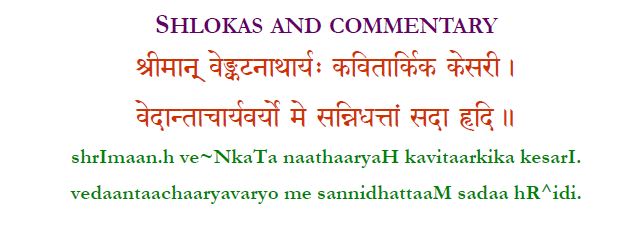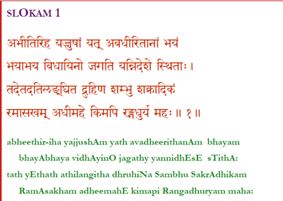INTRODUCTION:” ABHIDISTHAVAM”
Swamy Desikan’s period was between 1268 to 1369A.D. He witnessed many historical events and contributed enormously to the growth and sustenance of Sri Bhagawad Ramanuja tenets.One of the most important events in his life is the title given by Sri Ranganathar as “VEDANTHACHARYA” and as “SARVATHANTRA SWATHANTRAR” by Sri Ranganayaki Thayar, during the composition of “ABHIDISTHAVAM”
During the first invasion of Muslims in 1311 A.D,Swamy was 55 years old and was one of the most revered Vaishnavca Acharyas, who composed many grantas and conducted many Vedantha kalakshebham to advance the glorious tenets of Sri Ramanujacharya. A disturbing incident happened when Muslim invasion took place.
Swamy and many other key personalities in Srirangam temple, decided to move the Archa murthy of Moolavar Sri RanganathaPerumal and Thayar Ranganayaki away from the invasion at a safe distance. So, they constructed a great wall in front of Deities. The main priest, Sudarshana Bhattar, along with few others shifted the deities to Tirupathi and did all the Arahanam for few months in a way which doesnot attract many devotees, in a simple way. Sudarshana Bhattar, was the author of Srutha Prakasika, the commentary on Sribashyam, following strictly the Sribashyam of Sri ramanujar.
He requested Swamy Desikan not to be along with divyadampathis, as this would be easier for muslims to trace deities. So, Swamy moved to Sathyamangalam with great pain, but continued with his grantams and Kalakshepam there. He could not stay without Darshan of Divya Dampathi, so he went to Tirumala hills. Sudarshana bhattar told Swamy to preserve Sruta Prakasika and his two sons. Out of his great affection for Sribashyam,swamy accepted to move to Sathyamangalam for peace.
From there, he went to Thirunarayanapuram to worship Selvapillai and Ramanujar, where he composed “Yathiraja Sapthadhi” and “Abhidisthavam”, who couldnot bear the pain of separation of Divyadampathi, in the style of sthavam. He chanted this many times and thus peace returned to Srirangam,by the Chenji king Koopaanarryan. King went to tirupathi and brought back the Archa murthy to Sriranagm after a brief sojourn at Chenji. Hearing this good news,Swamy Desikan returned to Srirangam with a mental peace that, he would reunion with Divya Dampathis.


(MEANING):
At the Divya desam of Srirangam, the Supreme jyothi with the name of Sri Ranganathan
descended from SriVaikuntam with His divine consort and appears before us. This Supreme
Jyothi carries out the activities of creation, protection and dissolution with the sheer power of
‘Supreme Jyothi’, its sankalpam. When one approaches this Jyothi- svaroopa of Sri Ranganathan with devotion, all the fears arising from the bonds of SamsAram will be destroyed. This Lord of Srirangam
will create fear in those discarded by Him. For such unfortunate ones, the Samsara Bhayam
will persist. Those chetanams, who cause fear for the people or remove the fear of the people
are the servants of the Lord of Srirangam and execute His orders. This Lord of Srirangam is
the Supreme Being (Para Devathai) over Brahma, Sivan and Indhran. May we meditate on
this Lord of Srirangam with such Vaibhavam along with His Devi!
SPECIAL COMMENTS ON THE WORDS OF THE SLOKAM:
The key words in this slokam are:
“Ramaa-sakham Rangadhuryam yethath kimapi Maha: adheemahe”
Swamy Desikan says that there is a wondrous, indescribable Jyothi / Tejas (Kimapi Yethath
Maha:) at Srirangam that appears before us with Sri RanganAyaki. We reflect on that Jyothi
and bow before that Supreme effulgence.
This supreme JyOthi is seen with Periya PirAtti (Ramaa-sakham) and is the Lord of
Srirangam (Ranga dhuryam). We meditate on this Supreme JyOthi (yEthath Maha:
adheemahE) accompanied by Sri RanganAyaki (Ramaa-sakham yEthath Maha:) with its
abode at Srirangam (Rangadhuryam yEthath Maha: adheemahE).
This Supreme JyOthi (Svayam-PrakAsa ParamjyOthi) creates freedom from fear of any kind
for those in this world (iha loke), who seek its protection (iha yath jushAm abheethi:).
The Jyothir Brahma Tatthvam celebrated in ChAndOgya Upanishad and interpreted by
Acharya RaamAnujA in Sri BhAshyam is refered to here as “Kimapi Maha:”. Mundaka
Upanishad identifies this Jyothi as the shining One, everything shines after; by this Jyothi all
jyothis are illumined.
The same Supreme Jyothi creates bhayam in those, who are discarded by it (Yath
avadheerithanam bhayam).
Those chetanams, which cause fear and remove fear (bhaya-abhaya vidhAyina:) in this world
(Jagathy) are under the control of that Supreme Jyothi (yath nidheses Titha:).
That Supreme Jyothi at Srirangam surpasses the Vaibhavam of Brahma, Sivan and Indhran
et al (Tath athilangitha dhruhiNa- Sambhu- SakrAdhikam). It is the Para Devathai, whose
vaibhavam is not equaled or exceeded by any other Devathai.
We meditate on such a Supreme Jyothi with Its PirAtti at Srirangam and are blessed with
abheethi /abhayam.
A. COMMENTS FROM GAARGYA SRI VENKATACCHAR SWAMY ON THE FIRST SLOKAM
OF ABHEETHI STHAVAM:
- Abheethi here refers to Samsara Nivrutthi (Banishment of the fears arising from being
whirled about in the ocean of Samsaram). - “Tath yethath kimapi Rangadhuryam maha: adheemahE” is the key message of the first
slokam. “That” is the Brahman experienced only through VedAntha vichAram. This can not
be seen by Maamsa Chakshus (physical eyes of ours). yEthath however is the Lord in Archaa
form that could be seen by the human eyes here at Srirangam. This Archaa Moorthy is
equivalent to Para Brahman (Para VaasudEvan not seen while we are embodied; it is
experienced by Muktha Jeevans and Nithya Sooris). - Sri VenkatAcchAr Swamy opines that the first half of this slOkam is about the first two
chapters of Brahma Soothrams (BRS) and the second half is about the third and the fourth
Chapters of the Saareeraka Saasthram (BRS).
B. COMMENTS FROM SRI RANGANATHACCHAR SWAMY ON KEY WORDS & PASSAGES: - For those, who have taken refuge in Sri RanganAtha, there will be no fears in this and the
other world. For those, who discard Him, there will be all kinds of fears in all lOkams. For
AasrithAs, He is Aasritha Soulabhyan (ease of access) and for those Prathikoolars that display
enimity to Him, He is dhurjayan (invincible). - “Ramaa sakham”: The Supreme One, who is always found in the company of MahA
Lakshmi (Sri Ranga Naayaki) and Her darling is the direct meaning. The subtle meaning is
the yEkasEshithvam based on one definition of the word, “Sakhaa”. SamayOrEva sakhyam.
She is equal to Him from the Bruhathva, (Jagath) KaaraNathva and Iswarathvam aspects.
Therefore the MahA tEjas (vilakshaNa tEjas: tath yEthath kimapi Maha:) at Srirangam is
the “Ramaa Sakhan”. Rangadhuryam Maha: is the tEjas recognized as Sri RanganAthan. He
is Sadhaa Sannihithan (always near to us in the Archaa form at Srirangam). - “yEthath Maha: adheemahE”: we perform meditation (anusandhAnam, adhyayanam) of
this great Svayam Jyothi.
C. COMMENTS FROM SRI ANBIL GOPALACCHAR SWAMY ON THE FIRST SLOKAM: - The prayer in this sthOthram is for abhaya siddhi from Sri Ranganathan by making Him
Jushtan (pleased). - “Kimapi Maha:”: Kimapi here stands for apramEya tEjas (maha:). This Ranga tEjas is
Pranava tejas and is fitting for anusandhAnam (hence adheemahE). - “Ranga dhuryam” means Sri RanganAthan, who is the bearer of the RakshaNa bharam of
Sriranga LeelA VibhUthi at one level. “dhurya” sabdham also means Asvam (Hayagreevan,
the UpAsanaa Moorthy of Swamy Desikan). Hence it has been suggested that the
resplendent Jyothi at Srirangam (Rangadhuryam maha:) also refers to the HayagrIva tEjas
that appeared before Swamy Desikan on top of the OushadhAdhri at Thiruvaheendhrapuram.
Sloka 2:
To be continued……..
Source:Oppiliappan Koil Sri.V. Sadagopan Swamy








